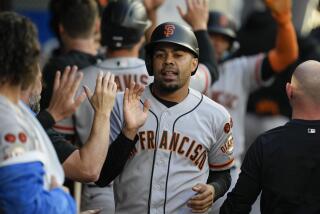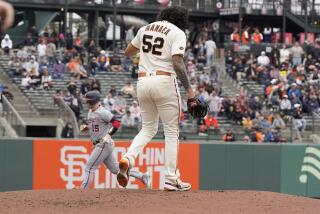Giants Can’t Figure Out Reason for the Big Fall
- Share via
EAST RUTHERFORD, N.J. — After taking one of the hardest falls among Super Bowl champions in history, the New York Giants are left wondering what went wrong in 1987 and what can be done to correct a shell-shocked team.
The Giants reported to training camp in July convinced they were prepared to become the first team to repeat as Super Bowl champions in eight years. Instead, the franchise has endured a season divided into three frustrating sections--an 0-2 start, an 0-3 strike team and a 2-2 record in a desperate attempt to qualify for the playoffs after the strike ended.
Outside of the strike games, the Giants’ regulars are 3-4. The worst finish of a defending Super Bowl champion was San Francisco’s 3-6 record in the 1982 strike season. Two other Super Bowl winners have suffered losing seasons the following year.
“If somebody would’ve told me before the season that we would lose four games during the course of the 16-game season, I would’ve laughed in their face,” said Giants’ safety Kenny Hill.
The laugh has been on the Giants. They were manhandled by Chicago in their opener, lost two games in the fourth quarter against Dallas and were used as a stepping stone by upstart New Orleans last week. Heading into Sunday’s game against division rival Washington, the Giants can only hope to play spoiler while the Redskins try for an early playoff clinching.
“I thought we had the makings of a great team,” said outside linebacker Lawrence Taylor, the NFL’s best player in 1986. “It’s frustrating. I’m thinking what the hell I’m going to do in January.”
The Giants have been in the playoffs three straight years, since going 3-12-1 in 1983 during Bill Parcells’ first year as head coach. They had improved markedly each year, until crashing like the stock market this year.
“It makes you more aware of things, reinforces things you know you have to do that maybe you didn’t do for one reason or another,” Parcells said of this season. “Sometimes it hits you in the face and you say, ‘Gee whiz.’
“You hope you can get another year out of this guy or that guy, or better performance out of a segment of your team although you see evidence that you might not. But sometimes your options are limited. There are some things you can’t control.”
The Giants will spend the rest of this season and the off-season determining how to improve the things they can control. It figures to be a disturbing eight months between now and the next training camp.
“There’s a fine line between winning and losing, but when you win you start thinking you’re better than you are,” guard Billy Ard said. “When you lose, you start thinking you’re worse than you are. This is a black and white game, there’s no gray area.”
There seems to be three major reasons for the Giants’ fade to black:
--A collapse of the offensive line.
--A lack of preparation for strike games, leading to an 0-3 record.
--An evening of the breaks that went in their favor last season.
Parcells refuses to place too much of the blame on any one unit, but has been disappointed by the offensive line--one of his favorite units in the past.
“There’s a lot of segments of our team that could be playing better and more consistent,” Parcells said. “And certainly that group is among them.”
The Giants’ first crisis of 1987 came during the exhibition season when right offensive tackle Karl Nelson was stricken with Hodgkins’ disease. News of his illness shook up his teammates more than any injury could, but he has responded to treatment and could be back next year.
Still, the Giants never recovered from his absence. William Roberts, a first-round draft choice in 1984, struggled in his place and the Giants’ running game never approached its 1986 excellence.
“That contributed to the situation,” Ard said of Nelson’s illness. “He was the best drive blocker we had.”
An injury to right guard Chris Godfrey and Parcells’ decision to bench blocking back Maurice Carthon in favor of George Adams also weakened the running game. Joe Morris, off Pro Bowl seasons in 1985 and 1986 when he ran for an average of 1,426 yards per year and 4.5 yards per rush and totalled 35 touchdowns, now averages 3.2 yards per carry with one touchdown.
As a team, the Giants have slipped from 4.0 yards per rush in 1986 to 3.4 this year.
“We’ve not had the success we wanted running the ball,” said Morris, who has been bothered by injuries to his ankle, knee and sternum. “Everybody makes changes, just not as many as we have. The last year two years everybody was here together. We were consistent, that’s one thing we haven’t had all year.
“This is not the same as last year. There’s no comparison. There was no strike last year.”
Unlike many teams, Giants’ management did not prepare for replacement games and put a rag-tag unit on the field while their regular players walked picket lines. The regulars returned in an 0-5 hole that was too big to dig out of.
“We felt we would win most of our remaining games, which we probably will do,” Hill said. “But we were in a position that was tough to extricate ourselves from.”
Here’s how much the strike hurt: the Redskins’ regulars have won one more game than the Giants.
Like most Super Bowl champions, everything seemed to break right for the Giants in 1986. Injuries were at a minimum, their big plays far outweighed crucial mistakes and they had a knack for pulling out close games.
All that changed in 1987. Besides Nelson, Godfrey and Morris, the Giants’ injury list included quarterback Phil Simms, Taylor, wide receiver Stacy Robinson and cornerback Perry Williams.
The Giants also lost most of their close games this year. They won four games in the fourth quarter in 1986, two on Raul Allegre field goals in the final minute. This year Allegre missed a 46-yarder in the final seconds that would have beaten Dallas in the second week, and he has failed on 5 of 12 attempts this season.
More to Read
Go beyond the scoreboard
Get the latest on L.A.'s teams in the daily Sports Report newsletter.
You may occasionally receive promotional content from the Los Angeles Times.










